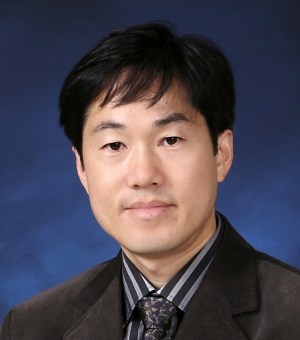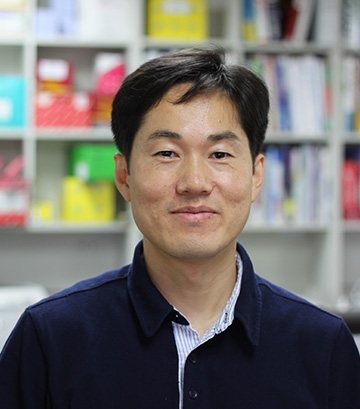Huh, Won-Ki
The objective of the Laboratory of Molecular and Cellular Proteomics is to identify novel regulators of various cellular processes and elucidate their action mechanisms at the molecular and cellular levels. We are using the functional genomic and proteomic strategies in addition to the biochemical, molecular biological, cell biological methods for studying the following topics:
1. Functional study of human GPCR heteromers
- Identification of new GPCR heteromers
- Investigation of functional roles of GPCR heteromerization
- Development of drugs targeting GPCR heteromers
2. In vivo analysis of protein interaction network
- Development of platforms for genome-wide BiFC assay
- Systematic analysis of human GPCR heteromerization network
- Global analysis of protein interaction network in yeast
3. Dissection of signaling pathways regulating cell growth, proliferation, and death
- Analysis of TOR kinase interactome
- Relationship between TOR signaling pathway and autophagy
- Investigation of rDNA silencing factors
Education
- - 1994.03 - 1998.08 Ph.D.: Biophysics, Seoul National University
- - 1992.03 - 1994.02 Master: Biophysics, Seoul National University
- - 1987.03 - 1992.02 Bachelor: Microbiology, Seoul National University
Career
- - 2023 - present Chair, School of Biological Sciences, Seoul National University
- - 2020 - 2023 Director, Institute of Microbiology, Seoul National University
- - 2013 - present Co-founder/CTO, GPCR Therapeutics, Inc.
- - 2013 - present Professor, School of Biological Sciences, Seoul National University
- - 2012 - 2014 Vice Dean, College of Natural Sciences, Seoul National University
- - 2008 - 2013 Associate Professor, School of Biological Sciences, Seoul National University
- - 2004 - 2008 Assistant Professor, School of Biological Sciences, Seoul National University
- - 2001 - 2004 Postdoctoral Fellow, UC San Francisco
- - 1998 - 2001 Research Associate, Molecular Microbiology Research Center, Seoul National University
- Hong, S., Lee, H., and Huh, W.-K.* (2024) ARV1 deficiency induces lipid bilayer stress and enhances rDNA stability by activating the unfolded protein response in Saccharomyces cerevisiae. J. Biol. Chem. (In press)
- Liang, J., Seghiri, M., Singh, P. K., Seo, H. G., Lee, J. Y., Jo, Y., Song, Y. B., Park, C., Zalicki, P., Jeong, J.-Y., Huh, W.-K., Caculitan, N. G.*, Smith, A. W.* (2024) The β2-adrenergic receptor associates with CXCR4 multimers in human cancer cells. Proc. Natl. Acad. Sci. U. S. A. 121(14):e2304897121.
- Choi, C., Bae, J., Kim, S., Lee, S., Kang, H., Kim, J., Bang, I., Kim, K., Huh, W.-K., Seok, C., Park, H., Im, W., Choi, H.J. (2023) Understanding the molecular mechanisms of odorant binding and activation of the human OR52 family. Nat. Commun. 14(1):8105.
- Sukhtankar, D. D., Fung, J. J., Kim, M-n., Cayton, T., Chiou, V., Caculitan, N. G., Zalicki, P., Kim, S., Jo, Y., Kim, S., Lee, J. M., Choi, J., Mun, S., Chin, A., Jang, Y., Lee, J. Y., Kim, G., Kim, E. H., Huh, W.-K., Jeong, J.-Y., Seen, D.-S., Cardarelli, P. M.* (2023) GPC-100, a novel CXCR4 antagonist, improves in vivo hematopoietic cell mobilization when combined with propranolol. PLoS One 18(10):e0287863.
- Hong, J. M., Lee, J.-W., Seen, D.-S., Jeong, J.-Y., and Huh, W.-K. (2023) LPA1-mediated inhibition of CXCR4 attenuates CXCL12-induced signaling and cell migration. Cell Commun. Signal. 21:257.
- Lee, Y., Kim, B., Jang, H.-S., and Huh, W.-K. (2023) Atg1-dependent phosphorylation of Vps34 is required for dynamic regulation of the phagophore assembly site and autophagy in Saccharomyces cerevisiae. Autophagy 19(9):2428-2442.
- Park, C., Lee, J.-W., Kim, K., Seen, D.-S., Jeong, J.-Y., and Huh, W.-K. (2023) Simultaneous activation of CXC chemokine receptor 4 and histamine receptor H1 enhances calcium signaling and cancer cell migration. Sci. Rep. 13:1894.
- Jung, S.-J., Yun, M., Yim, C., Hong, S., Huh, W.-K., and Kim, H. (2022) Expression level of Sec62 modulates membrane insertion of marginally hydrophobic segments. Biochim. Biophys. Acta, Biomembr. 1864(12):184051.
- Ramesh, R., Dautel, M., Lee, Y., Kim, Y., Storey, K., Gottfried, S., Goss Kinzy, T., Huh, W.-K., and Sattlegger, E. (2021) Asp56 in actin is critical for the full activity of the amino acid starvation-responsive kinase Gcn2. FEBS Lett. 595(14):1886-1901.
- Hong, S. and Huh, W.-K. (2021) Loss of Smi1, a protein involved in cell wall synthesis, extends replicative lifespan by enhancing rDNA stability in Saccharomyces cerevisiae. J. Biol. Chem. DOI: 10.1074/jbc.RA120.015456.
- Kim, B., Lee, Y., Choi, H., and Huh, W.-K. (2021) The trehalose-6-phosphate phosphatase Tps2 regulates ATG8 transcription and autophagy in Saccharomyces cerevisiae. Autophagy 17(4):1013-1027.
- Chang, Y., Lim, G., and Huh, W.-K. (2021) Analysis of the TORC1 interactome reveals spatially distinct function of TORC1 in mRNP complexes. J. Cell Biol. 220(4):e201912060.
- Lim, G., Chang, Y., and Huh, W.-K. (2020) Phosphoregulation of Rad51/Rad52 by CDK1 functions as a molecular switch for cell cycle-specific activation of homologous recombination. Sci. Adv. 6(6):eaay2669.
- Singh, K., Lee, M. E., Entezari, M., Jung, C.-H., Kim, Y., Park, Y., Fioretti, J. D., Huh, W.-K., Park, H.-O., Kang, P. J. (2019) Genome-wide studies of Rho5-interacting proteins that are involved in oxidant-induced cell death in budding yeast. G3 (Bethesda). 9(3):921-931.
- Kim, Y., Jung, J. P., Pack, C.-G., and Huh, W.-K. (2019) Global analysis of protein homomerization in Saccharomyces cerevisiae. Genome Res. 29(1):135-145.
- Li, H.-M., Jang, J. H., Jung, J.-S., Shin, J., Park, C. O., Kim, Y.-J., Ahn, W.-G., Nam, J.-S., Hong, C.-W., Lee, J., Jung, Y.-J., Chen, J.-F., Ravid, K., Lee, H. T., Huh, W.-K., Kabarowski, J. H., and Song, D.-K. (2019) G2A protects mice against sepsis by modulating Kupffer cell activation: Cooperativity with adenosine receptor 2b. J. Immunol. 202(2):527-538.
- Yi, D.-G., Hong, S., and Huh, W.-K. (2018) Mitochondrial dysfunction reduces yeast replicative lifespan by elevating RAS-dependent ROS production by the ER-localized NADPH oxidase Yno1. PLoS One. 13(6):e0198619.
- Sing, T., Hung, M. P., Ohnuki, S., Suzuki G., San Luis, B.-J., McClain, M., Unruh, J., Yu, Z., Ou, J., Marshall-Sheppard, J., Huh, W.-K., Costanzo, M., Boone, C., Ohya, Y., Jaspersen, S., and Brown, G. (2018) The budding yeast RSC complex maintains ploidy by promoting spindle pole body insertion. J. Cell Biol. 217(7):2445-2462.
- Chang, Y., and Huh, W.-K. (2018) Ksp1-dependent phosphorylation of eIF4G modulates post-transcriptional regulation of specific mRNAs under glucose deprivation conditions. Nucleic Acids Res. 46(6):3047-3060.
- Choi, J.-H., Jeong, Y.-M., Kim, S., Lee, B., Ariyasiri K., Kim, H.-T., Jung, S.-H., Hwang, K.-S., Choi, T.-I., Park, C. O, Huh, W.-K., Carl, M., Rosenfeld, J. A., Raskin, S., Ma, A., Gecz, J., Kim, H.-G., Kim, J.-S., Shin, H.-C., Park, D.-S., Gerlai, R., Jamieson, B. B., Kim, J. S., Iremonger, K. J., Lee, S. H., Shin, H.-S., and Kim, C.-H. (2018) Targeted knockout of a chemokine-like gene increases anxiety and fear responses. Proc. Natl. Acad. Sci. U.S.A. 115(5):E1041-E1050.
- Lim, G., and Huh, W.-K. (2017) Rad52 phosphorylation by Ipl1 and Mps1 contributes to Mps1 kinetochore localization and spindle assembly checkpoint regulation. Proc. Natl. Acad. Sci. U.S.A. 114(44):E9261-E9270.
- So, Y. S., Yang, D. H., Jung, K. W., Huh, W.-K., and Bahn, Y. S. (2017) Molecular characterization of adenylyl cyclase complex proteins using versatile protein-tagging plasmid systems in Cryptococcus neoformans. J. Microbiol. Biotechnol. 27(2):357-364.
- Yi, D.-G., Kim, M. J., Choi, J. E., Lee, J., Jung, J., Huh, W.-K., and Chung, W.-H. (2016) Yap1 and Skn7 genetically interact with Rad51 in response to oxidative stress and DNA double-strand break in Saccharomyces cerevisiae. Free Radic. Biol. Med. 101:424-433.
- Klionsky, D. J. et al. (2016) Guidelines for the use and interpretation of assays for monitoring autophagy (3rd edition). Autophagy 12(1):1-222.
- Yi, D.-G., and Huh, W.-K. (2015) UDP-glucose pyrophosphorylase Ugp1 is involved in oxidative stress response and long-term survival during stationary phase in Saccharomyces cerevisiae. Biochem. Biophys. Res. Commun. 467(4):657-663.
- Yi, D.-G., and Huh, W.-K. (2015) PKA, PHO and stress response pathways regulate the expression of UDP-glucose pyrophosphorylase through Msn2/4 in budding yeast. FEBS Lett. 589(18):2409-2416.
- Miller, K. E., Kim, Y., Huh, W.-K., and Park, H.-O. (2015) Bimolecular fluorescence complementation (BiFC) analysis: advances and recent applications for genome-wide interaction studies. J. Mol. Biol. 427(11):2039-2055.
- Lee, K., Sung, M.-K., Kim, J., Kim, K., Paik, H., Kim, B., Huh, W.-K., and Ideker, T. (2014) Proteome-wide remodeling of protein location and function by stress. Proc. Natl. Acad. Sci. U.S.A. 111(30):E3157-E3166.
- Ha, C. W., Kim, K., Chang, Y. J., Kim, B., and Huh, W.-K. (2014) The β-1,3-glucanosyltransferase Gas1 regulates Sir2-mediated rDNA stability in Saccharomyces cerevisiae. Nucleic Acids Res. 42(13):8486-8499.
- Song, Y. B., Park, C. O, Jeong, J.-Y., and Huh, W.-K. (2014) Monitoring G protein-coupled receptor activation using an adenovirus-based beta-arrestin bimolecular fluorescence complementation assay. Anal. Biochem. 449:32-41.
- Sung, M.-K., Lim, G., Yi, D.-G., Chang, Y. J., Yang, E. B., Lee, K., and Huh, W.-K. (2013) Genome-wide bimolecular fluorescence complementation analysis of SUMO interactome in yeast. Genome Res. 23(4):736-746.
- Choi, E.-W., Seen, D.-S., Song, Y. B., Son, H.-S., Jung, N.-C., Huh, W.-K., Hahn, J.-S., Kim, K., Jeong, J.-Y., and Lee, T. G. (2012) AdHTS: A high-throughput system for generating recombinant adenoviruses. J. Biotechnol. 162(2-3):246-252.
- Ha, C. W., Sung, M.-K., and Huh, W.-K. (2012) Nsi1 plays a significant role in the silencing of ribosomal DNA in Saccharomyces cerevisiae. Nucleic Acids Res. 40(11):4892-4903.
- Klionsky, D. J. et al. (2012) Guidelines for the use and interpretation of assays for monitoring autophagy. Autophagy 8(4):445-544.
- Pu, J., Ha, C. W., Zhang, S., Jung, J. P., Huh, W.-K., and Liu, P. (2011) Interactomic study on interaction between lipid droplets and mitochondria. Protein Cell 2(6):487-496.
- Shin, C.-S., and Huh, W.-K. (2011) Bidirectional regulation between TORC1 and autophagy in Saccharomyces cerevisiae. Autophagy 7(8):854-862.
- Ha, C. W., and Huh, W.-K. (2011) The implication of Sir2 in replicative aging and senescence in Saccharomyces cerevisiae. Aging 3(3):319-324.
- Kim, Y., Chay, K.-O., Song, Y. B., Kim, T.-Y., Kim, I., Han, S.-J., Ahn, Y., Cho, S.-H., Hoe, K.-L., Ahn, B. W., Huh, W.-K., and Lee, S.-R. (2011) Redox regulation of the tumor suppressor PTEN by glutaredoxin 5 and Ycp4. Biochem. Biophys. Res. Commun. 407(1):175-180.
- Lee, P., Paik, S. M., Shin, C. S., Huh, W.-K., and Hahn, J. S. (2011) Regulation of yeast Yak1 kinase by PKA and autophosphorylation-dependent 14-3-3 binding. Mol. Microbiol. 79(3):633-646.
- Ha, C. W., and Huh, W.-K. (2011) Rapamycin increases rDNA stability by enhancing association of Sir2 with rDNA in Saccharomyces cerevisiae. Nucleic Acids Res. 39(4):1336-1350.
- Chang, Y. J., Shin, C.-S., Han, D., Kim, J., Kim, K., Kwon, Y.-M., and Huh, W.-K. (2010) Genomewide profiling of rapamycin sensitivity in Saccharomyces cerevisiae on synthetic medium. Genomics & Informatics 8(4):177-184.
- Bandyopadhyay, S., Mehta, M., Kuo, D., Sung, M.-K., Chuang, R., Jaehnig, E. J., Bodenmiller, B., Licon, K., Copeland, W., Shales, M., Fiedler, D., Dutkowski, J., Guénolé, A., van Attikum, H., Shokat, K. M., Kolodner, R. D., Huh, W.-K., Aebersold, R., Keogh, M.-C., Krogan, N. J., and Ideker, T. (2010) Rewiring of genetic networks in response to DNA damage. Science 330(6009):1385-1389.
- Sung, M.-K., and Huh, W.-K. (2010) In vivo quantification of protein-protein interactions in Saccharomyces cerevisiae using bimolecular fluorescence complementation assay. J. Microbiol. Methods 83(2): 194–201.
- Kim, Y., Song, Y. B., Kim, T.-Y., Kim, I., Han, S.-J., Ahn, Y., Cho, S.-H., Chay, K.-O., Yang, S. Y., Ahn, B. W., Huh, W.-K., and Lee, S.-R. (2010) Redox regulation of the tumor suppressor PTEN by glutathione. FEBS Lett. 584(16):3550-3556.
- Song, Y. B., Jhun, M. A., Park, T., and Huh, W.-K. (2010) Quantitative proteomic analysis of ribosomal protein L35b mutant of Saccharomyces cerevisiae. Biochim. Biophys. Acta 1804:676-683.
- Shin, C.-S., Chang, Y.-J., Lee, H.-G., and Huh, W.-K. (2009) Rapamycin-Induced Abundance Changes in the Proteome of Budding Yeast. Genomics & Informatics 7:203-207.
- Shin, C.-S., Kim, S. Y., and Huh, W.-K. (2009) TORC1 Controls Degradation of Transcription Factor Stp1, a Key Effector of the SPS Amino Acid-Sensing Pathway in Saccharomyces cerevisiae. J. Cell Sci. 122:2089-2099.
- Kim, T.-Y., Ha, C. W., and Huh, W.-K. (2009) Differential Subcellular Localization of Ribosomal Protein L7 Paralogs in Saccharomyces cerevisiae. Mol. Cells 27:539-546.
- Lee, K. Y., Chuang, H.-Y., Beyer, A., Sung, M.-K., Huh, W.-K., Lee, B., and Ideker, T. (2008) Protein networks markedly improve prediction of subcellular localization in multiple eukaryotic species. Nucleic Acids Res. 36:e136.
- Sung, M.-K., Ha, C. W., and Huh, W.-K. (2008) A vector system for efficient and economical switching of C-terminal epitope tags in Saccharomyces cerevisiae. Yeast 25:301-311.
- Huh, W.-K., Song, Y. B., Lee, Y.-S., Ha, C. W., Kim, S.-T., and Kang, S.-O. (2008) D-Erythroascorbic acid activates cyanide-resistant respiration in Candida albicans. Biochem. Biophys. Res. Commun. 369:401-406.
- Lee, H.-G., Lee, H.-S., Jeon, S.-H., Chung, T.-H., Lim, Y.-S., and Huh, W.-K. (2008) High-resolution analysis of condition-specific regulatory modules in Saccharomyces cerevisiae. Genome Biol. 9:R2.
- Sung, M.-K., and Huh, W.-K. (2007) Bimolecular fluorescence complementation analysis system for in vivo detection of protein-protein interaction in Saccharomyces cerevisiae. Yeast 24:767-775.
- Lee, M.-W., Kim, B.-J., Choi, H.-K., Ryu, M.-J., Kim, S.-B., Kang, K.-M., Cho, E.-J., Youn, H.-D., Huh, W.-K., and Kim, S.-T. (2007) Global protein expression profiling of budding yeast in response to DNA damage. Yeast 24:145-154.
- Howson, R., Huh, W.-K., Ghaemmaghami, S., Falvo, J. V., Bower, K., Belle, A., Dephoure, N., Wykoff, D. D., Weissman, J. S., and O’Shea, E. K. (2005) Construction, verification and experimental use of two epitope-tagged collections of budding yeast strains. Comp. Funct. Genom. 6:2-16.
- Ghaemmaghami, S., Huh, W.-K., Bower, K., Howson, R., Belle, A., Dephoure, N., O'Shea, E. K., and Weissman, J. S. (2003) Global analysis of protein expression in yeast. Nature 425:737-741.
- Huh, W.-K., Falvo, J., Gerke, L., Carroll, A., Howson, R., Weissman, J. S., and O'Shea, E. K. (2003) Global analysis of protein localization in budding yeast. Nature 425:686-691.



